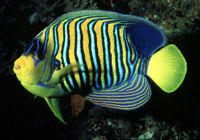Difference between revisions of "Pygoplites diacanthus"
From The Aquarium Wiki
| Line 40: | Line 40: | ||
|sexing=:Males are larger; like other angelfishes, they are protogynous hermaphrodites. | |sexing=:Males are larger; like other angelfishes, they are protogynous hermaphrodites. | ||
|tank_compatibility=:A relatively peaceful fish suitable for peaceful communities and is considered reef safe, although may nip at stony corals, zoanthids and some clams. Can be kept in groups in a very large system. | |tank_compatibility=:A relatively peaceful fish suitable for peaceful communities and is considered reef safe, although may nip at stony corals, zoanthids and some clams. Can be kept in groups in a very large system. | ||
| − | |diet=:The Regal Angel prefers a varied diet of [[spirulina]] and marine algae as well as [[mysid shrimp]] and other prepared meaty foods. | + | |diet=:The Regal Angel prefers a varied diet of [[spirulina]] and marine algae as well as [[mysid shrimp]] and Angel Formula and other Sponge-containing foods, as well as other prepared meaty foods. |
|feeding_regime=:Feed once or twice a day. | |feeding_regime=:Feed once or twice a day. | ||
|environment_specifics=:Prefers a spacious tank with plenty of live rock and hiding places. Needs an [[SG]] of 1.020 - 1.023. | |environment_specifics=:Prefers a spacious tank with plenty of live rock and hiding places. Needs an [[SG]] of 1.020 - 1.023. | ||
| − | |behaviour=:Generally peaceful towards tank mates. More aggressive species may harass them; for this reason, It is advisable to introduce them | + | |behaviour=:Generally peaceful towards tank mates. More aggressive species may harass them; for this reason, It is advisable to introduce them before more aggressive species, such as Tangs or other Angelfish. |
|identification=:This fish has a vivid oval-shaped greenish-yellow, with some locales having yellower bodied specimens, body and fins. The [[anal fin|anal]], and [[dorsal fin|dorsal]] fins are edged with vivid blue, and the flanks, and fins are striped with vertical silvery-blue bars. | |identification=:This fish has a vivid oval-shaped greenish-yellow, with some locales having yellower bodied specimens, body and fins. The [[anal fin|anal]], and [[dorsal fin|dorsal]] fins are edged with vivid blue, and the flanks, and fins are striped with vertical silvery-blue bars. | ||
}} | }} | ||
==Notes== | ==Notes== | ||
| − | :*This species is notorious for fragility. Although these fish eagerly eat, they die soon | + | :*This species is notorious for fragility. Although these fish may eagerly eat, they usually die soon after from nutritional deficiencies or exposure to Cyanide. For the greatest chance of survival, choose specimens that are plump, and feed a wide variety of foods containing sponges. |
{{Categories | {{Categories | ||
Revision as of 21:29, 15 June 2020
Royal Angelfish
Pygoplites diacanthus
473 Litres (125 US G.)
20-25 cm (7.9-9.8")
8.1 - 8.4
22.2-25.6°C (72 -78 °F)
8-12 °d
1:1 M:F
5-12 years
Family
Pomacanthidae
| You can contribute to the Aquarium Wiki by expanding this article. Dont be shy!. |
Contents
Additional names
- Royal Angelfish, Regal Angelfish
Additional scientific names
- Chaetodon diacanthus, Holacanthus diacanthus
Origin
- Indo-Pacific; widespread in tropical water, with minor variations depending on wether it's from the Pacific Ocean, the Indian Ocean, or the Red Sea.
Sexing
- Males are larger; like other angelfishes, they are protogynous hermaphrodites.
Tank compatibility
- A relatively peaceful fish suitable for peaceful communities and is considered reef safe, although may nip at stony corals, zoanthids and some clams. Can be kept in groups in a very large system.
Diet
- The Regal Angel prefers a varied diet of spirulina and marine algae as well as mysid shrimp and Angel Formula and other Sponge-containing foods, as well as other prepared meaty foods.
Feeding regime
- Feed once or twice a day.
Environment Specifics
- Prefers a spacious tank with plenty of live rock and hiding places. Needs an SG of 1.020 - 1.023.
Behaviour
- Generally peaceful towards tank mates. More aggressive species may harass them; for this reason, It is advisable to introduce them before more aggressive species, such as Tangs or other Angelfish.
Identification
- This fish has a vivid oval-shaped greenish-yellow, with some locales having yellower bodied specimens, body and fins. The anal, and dorsal fins are edged with vivid blue, and the flanks, and fins are striped with vertical silvery-blue bars.
Notes
- This species is notorious for fragility. Although these fish may eagerly eat, they usually die soon after from nutritional deficiencies or exposure to Cyanide. For the greatest chance of survival, choose specimens that are plump, and feed a wide variety of foods containing sponges.
Pictures
Videos
Aquarium species profile: Aquarium keeping advice: Aquarium care overview:
External links
- Fishbase (Mirrors:
 )
)


